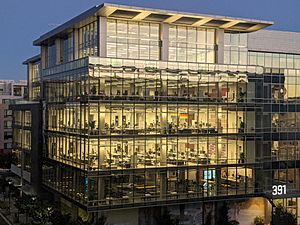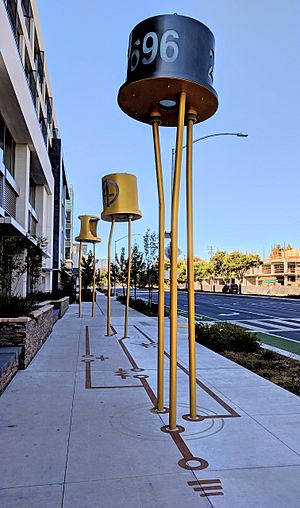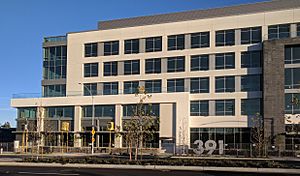Shockley Semiconductor Laboratory facts for kids

Shockley Semiconductor Laboratory was a very important company that helped start Silicon Valley. It was founded by a scientist named William Shockley in 1955. This company was the first high-tech business in the area to focus on devices made from silicon. These devices are called semiconductors.
In 1957, eight top scientists left the company. They went on to create Fairchild Semiconductor. Shockley Semiconductor never fully recovered after they left. It was bought by another company, Clevite, in 1960. Later, it was sold to ITT in 1968 and soon closed down. The building where it all began was later used as a store. By 2017, the site was rebuilt with new signs. These signs proudly call it the "Real Birthplace of Silicon Valley."
Contents
William Shockley's Journey to California
William Shockley studied at Caltech before moving to MIT. He earned his PhD in physics in 1936. Right after, he started working at Bell Labs. During the 1930s and 1940s, he worked on electronic devices. He became a leader in the field of solid-state electronics.
This work led to the invention of the first transistor in 1947. He worked with John Bardeen, Walter Brattain, and others. In the early 1950s, Shockley became unhappy with Bell Labs' management. He felt they did not give him enough credit for the transistor patent. Others who worked with him said Shockley was difficult to work with. This might have been why he was not promoted. In 1953, he took a break and became a visiting professor at Caltech.
Shockley became friends with Arnold Orville Beckman. Beckman had invented the pH meter in 1934. Shockley believed that silicon would replace germanium for making transistors. Texas Instruments had just started making silicon transistors in 1954. Shockley thought he could make an even better product. Beckman agreed to support Shockley's ideas through his company, Beckman Instruments.
Shockley wanted to live closer to his aging mother in Palo Alto. He began hiring top scientists. His first four PhD physicists were William W. Happ, George Smoot Horsley, Leopoldo B. Valdes, and Richard Victor Jones.
The Shockley Semiconductor Laboratory opened in 1956. It was in a small building in Mountain View. Shockley first tried to hire his old colleagues from Bell Labs. But they did not want to leave the East Coast. So, he built a team of young scientists and engineers. They worked on a new way to grow silicon crystals. This was very hard because silicon needs high heat to melt.
Shockley Diodes and Secrecy

While working on transistors, Shockley had a new idea. He thought of a four-layer device. Transistors usually have three layers. This new device could switch "on" or "off" and stay that way without more power. Other circuits needed many transistors to do this. So, Shockley's new diodes could make circuits much simpler. This four-layer device is now called the Shockley diode.
Shockley was sure this new device would be as important as the transistor. He kept the project a secret, even from his own company. This led to him acting very suspiciously. In one famous story, he thought a secretary's cut finger was a plot against him. He ordered everyone in the company to take lie detector tests.
Shockley also kept changing his mind about projects. Sometimes he wanted to make basic transistors right away. Other times, he focused on making the "perfect" production system for the Shockley diode. This made many employees upset, and small disagreements happened often.
The "Traitorous Eight" Depart
Eventually, a group of young employees decided to act. These were Julius Blank, Victor Grinich, Jean Hoerni, Eugene Kleiner, Jay Last, Gordon Moore, Robert Noyce, and Sheldon Roberts. They went to Arnold Beckman, asking him to replace Shockley. Beckman seemed to agree at first. But then he made choices that supported Shockley.
Feeling frustrated, the group left Shockley's company. They found support from Fairchild Camera and Instrument. This company was based in the Eastern U.S. and had many military contracts. In 1957, Fairchild Semiconductor was started. Their plan was to make silicon transistors. Shockley called these young scientists the "traitorous eight." He said they would never succeed.
The "eight" later left Fairchild and started their own companies. Over 20 years, 65 different companies began. These companies were started by people who worked at Shockley Semiconductor or their teams. Many of these companies trace their roots in Silicon Valley back to Shockley Semiconductor.
Shockley never made the four-layer diode a big success. Even though he worked out the technical details, it did not sell well. Later, integrated circuits came out. These allowed many transistors to be put on one "chip." This made Shockley's design less useful because it no longer saved space.
However, Shockley's company did have other successes. They did important research on solar cells. They developed the Shockley–Queisser limit. This limit shows that basic silicon solar cells can only be about 30% efficient at best.
|
See also
 In Spanish: Laboratorio Shockley de Semiconductores para niños
In Spanish: Laboratorio Shockley de Semiconductores para niños



